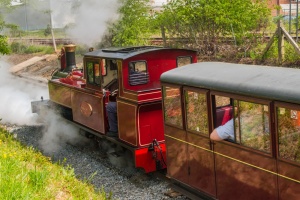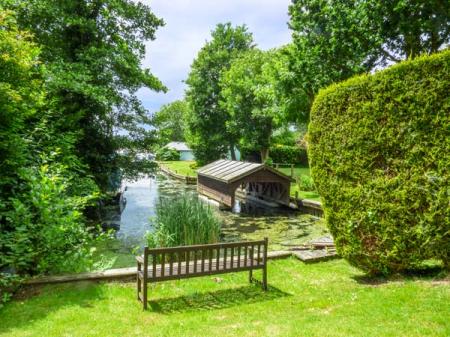
One of the most enjoyable ways to spend a summer's day is to simply sit by the river and watch the boats go by. Author Arthur Ransom of Swallows and Amazons fame described the riverside bustle at Wroxham in his popular 1934 book Coots Club.

locomotive under steam
The boats have to navigate the picturesque humpbacked bridge, built in 1619 to replace an earlier 16th century stone bridge, itself a replacement for a medieval timber bridge. Downstream of the bridge is Wroxham Broad, home of the Norfolk Broads Yacht Club and one of the best stretches of sailing water in the Broads.
There is a huge village shop known as Roys of Wroxham located near the low bridge across the River Bure. Roys claims to be the largest village store in the world, and once you see the size of it, you won't be inclined to argue! The store has stood since 1899 - on the Hoveton side of the bridge. You'd think it should really be called Roys of Hoveton!
The village lies on the south side of the river, while on the north is Hoveton, sometimes confused with Wroxham itself. In fact, most of the boatyards and shops are in Hoveton, not in Wroxham.
The historic church of St Mary is located away from the busy area around the bridge and seems to carry an aura of timeless peace. The south door is wonderful Norman work, described by Nikolaus Pevsner as 'barbaric and glorious'. Look for the Gothic mausoleum to the Trafford family, built by Anthony Salvin in 1831.
Not far from the church is Hoveton Hall Gardens, 15 acres of splendid formal and informal gardens set about an early 19th-century manor (not open to the public) and giving colour throughout most of the year.
A historic steam railway known as the Bure Valley Railway leads from Wroxham to Aylsham, a distance of 9 miles. The BVR is one of the most popular visitor attractions in the Norfolk Broads and a great way to gain an introduction to the area. If you fancy something a bit more energetic a footpath leads beside the rail line through wonderful countryside.






 We've 'tagged' this attraction information to help you find related historic attractions and learn more about major time periods mentioned.
We've 'tagged' this attraction information to help you find related historic attractions and learn more about major time periods mentioned.


